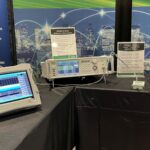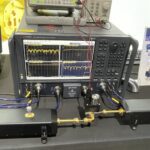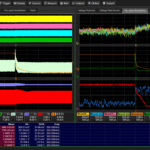USB oscilloscopes are highly versatile instruments. With the right software, they can perform functions usually reserved for spectrum analyzers and digitizers. In some cases, however, special instruments are needed for optimal results. This FAQ compares the functions of oscilloscopes, spectrum analyzers, and digitizers with USB interfaces. They are called USB devices because they connect to a companion PC through the USB interface that also powers the instrument.
Time domain vs frequency domain
USB oscilloscopes are often used to capture detailed timing information about a signal or the relative timing between multiple signals, for example, the delay time between signals. Spectrum analyzers are used to investigate the frequency properties of signals, for example, the harmonic content. USB spectrum analyzers come in a variety of package sizes. Some are pocket-sized like most USB oscilloscopes, but mini-USB spectrum analyzers are available that are even smaller. One is available that measures just 87.5 mm (L) x 23 mm (W) x 15 mm (H) and weighs less than 20 g (Figure 1).

Mini USB spectrum analyzers like this are specially designed for testing in the field. They can monitor RF signals when attached to an antenna for electromagnetic computability (EMC) testing with a near-field probe. The software also supports remote setup and monitoring through the Internet when attached to a host PC. It can handle frequencies up to 4.15 GHz, power up to 1 W, and a noise level of -110 dBm.
More standard-sized USB spectrum analyzers can capture 40 MHz real-time bandwidths. They have a 70 dB spurious-free dynamic range and frequency coverage of 18.0 GHz. An available tracking generator supports gain/loss measurements for quick tests of filters, duplexers, and other network elements. It also supports cable and antenna measurements of VSWR, return loss, distance to fault, and cable loss.
Digitizers
Wideband digitizers deliver high resolution, have high dynamic range, and can present the results in the frequency domain. USB digitizers are especially useful in applications like automatic test equipment (ATE) systems and high-density multichannel data acquisition where the analysis software and display can be embedded in a centralized controller.
For example, a 4-channel USB digitizer is available with high bandwidth 50 Ω inputs using SMA connectors (compared with the BMC connectors common on USB oscilloscopes) with fixed ±100 mV input ranges (Figure 2). Attenuators are available when higher input signals need to be accommodated. This digitizer has a 1 GHz bandwidth and a real-time sampling rate of 5 GS/sec that can capture single-shot pulses with a 200 ps time resolution. Two 100 ms captures at the maximum sampling rate can be held in the buffer memory.

The available software development kit (SDK) enables the oscilloscope to connect with third-party software including MathWorks’ MATLAB, Microsoft Excel, and NI LabVIEW. The SKD includes drivers for Microsoft Windows, Apple Mac (OS X), and Linux (including Raspberry Pi and BeagleBone). USB data streaming is supported by the drivers to enable capturing gap-free continuous data over the USB connection and safe it directly to RAM or a hard drive at rates up to 10 MS/sec.
Summary
USB oscilloscopes are highly versatile, but not a panacea. Some applications require higher levels of performance and can benefit from using dedicated USB spectrum analyzers and digitizers.
References
Understanding the Differences Between Oscilloscopes and Digitizers for Wideband Signal Acquisitions, Keysight
USB Oscilloscopes, Analyzers and Signal Generators, Digilent
USB Spectrum Analyzer, RF Instruments
USB Spectrum Analyzers, Tektronix
What is the difference between an oscilloscope and a spectrum analyzer?, Saluki Technology






Leave a Reply
You must be logged in to post a comment.